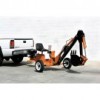Harbor Freight Tools 62365 User Manual - Page 5
Save These Instructions.
 |
View all Harbor Freight Tools 62365 manuals
Add to My Manuals
Save this manual to your list of manuals |
Page 5 highlights
Safety Setup Operating Precautions (cont.) 25. WARNING: This product contains or, when used, produces a chemical known to the State of California to cause cancer and birth defects or other reproductive harm. (California Health & Safety Code § 25249.5, et seq.) 26. WARNING: This product contains di (2-ethylhexyl) phthalate (DEHP), a chemical known to the State of California to cause cancer and birth defects or other reproductive harm. (California Health & Safety Code § 25249.5, et seq.) 27. Never place your hands or body near a hydraulic fluid leak. High-pressure fluid can be forced under the skin resulting in serious injury. Transport Precautions 1. Only use a suitable means of transport and lifting devices with sufficient weight bearing capacity when transporting the equipment. 2. Properly secure the equipment to transport vehicle to prevent it from rolling, slipping, and tilting. Service Precautions 1. Before service, maintenance, or cleaning: a. Turn the engine switch to its "OFF" position. b. Allow the engine to completely cool. c. Then, remove the spark plug wire from the spark plug. 2. Keep all safety guards in place and in proper working order. Safety guards include muffler, air cleaner, mechanical guards, and heat shields, among other guards. 3. Do not alter or adjust any part of the equipment or its engine that is sealed by the manufacturer or distributor. Only a qualified service technician may adjust parts that may increase or decrease governed engine speed. 4. Wear ANSI-approved safety goggles, heavy‑duty work gloves, and dust mask/respirator during service. 5. Do not allow the hydraulic hose to come in contact with any hot part of the unit. The hose might be damaged, possibly causing it to burst or leak under high pressure. 6. Maintain labels and nameplates on the equipment. These carry important information. If unreadable or missing, contact Harbor Freight Tools for a replacement. 28. When spills of fuel or oil occur, they must be cleaned up immediately. Dispose of fluids and cleaning materials as per any local, state, or federal codes and regulations. Store oil rags in a bottom-ventilated, covered, metal container. 29. Keep hands and feet away from moving parts. Do not reach over or across equipment while operating. 30. Before use, check for misalignment or binding of moving parts, breakage of parts, and any other condition that may affect the equipment's operation. If damaged, have the equipment serviced before using. Many accidents are caused by poorly maintained equipment. 31. Use the correct equipment for the application. Do not modify the equipment and do not use the equipment for a purpose for which it is not intended. 3. Always make sure the hitch coupler is securely fixed to the vehicle before moving it. If the Coupler is not secured properly, the link could come loose while the trailer is in motion, possibly causing property damage, SERIOUS PERSONAL INJURY, or DEATH. 4. Do not exceed 30 MPH when towing the Trencher. 5. Do not tow the Trencher on roads or highways. This product is not D.O.T. compliant, and is not road legal. 7. Have the equipment serviced by a qualified repair person using only identical replacement parts. This will ensure that the safety of the equipment is maintained. Do not attempt any service or maintenance procedures not explained in this manual or any procedures that you are uncertain about your ability to perform safely or correctly. 8. Store equipment out of the reach of children. 9. Follow scheduled engine and equipment maintenance. Refueling: 1. Do not smoke, or allow sparks, flames, or other sources of ignition around the equipment, especially when refuelling. 2. Do not refill the fuel tank while the engine is running or hot. 3. Refuel in a well-ventilated area only. 4. Wipe up any spilled fuel and allow excess to evaporate before starting engine. To prevent FIRE, do not start the engine while the smell of fuel hangs in the air. Operation Maintenance Item 62365 SAVE THESE INSTRUCTIONS. For technical questions, please call 1-888-866-5797. Page 5














